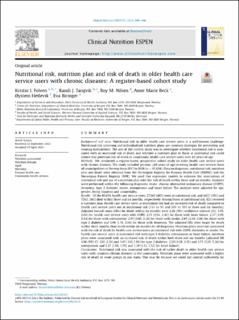| dc.description.abstract | Background and aims
Nutritional risk in older health care service users is a well-known challenge. Nutritional risk screening and individualised nutrition plans are common strategies for preventing and treating malnutrition. The aim of the current study was to investigate whether nutritional risk is associated with an increased risk of death and whether a nutrition plan to those at nutritional risk could reduce this potential risk of death in community health care service users over 65 years of age.
Methods
We conducted a register-based, prospective cohort study on older health care service users with chronic diseases. The study included persons ≥65 years of age receiving health care services from all municipalities in Norway from 2017 to 2018 (n = 45,656). Data on diagnoses, nutritional risk, nutrition plan and death were obtained from the Norwegian Registry for Primary Health Care (NRPHC) and the Norwegian Patient Registry (NPR). We used Cox regression models to estimate the associations of nutritional risk and use of a nutrition plan with the risk of death within three and six months. Analyses were performed within the following diagnostic strata: chronic obstructive pulmonary disease (COPD), dementia, type 2 diabetes, stroke, osteoporosis and heart failure. The analyses were adjusted for age, gender, living situation and comorbidity.
Results
Of the 45,656 health care service users, 27,160 (60%) were at nutritional risk, and 4437 (10%) and 7262 (16%) died within three and six months, respectively. Among those at nutritional risk, 82% received a nutrition plan. Health care service users at nutritional risk had an increased risk of death compared to health care service users not at nutritional risk (13% vs 5% and 20% vs 10% at three and six months). Adjusted hazard ratios (HRs) for death within six months were 2.26 (95% confidence interval (CI): 1.95, 2.61) for health care service users with COPD, 2.15 (1.93, 2.41) for those with heart failure, 2.37 (1.99, 2.84) for those with osteoporosis, 2.07 (1.80, 2.38) for those with stroke, 2.65 (2.30, 3.06) for those with type 2 diabetes and 1.94 (1.74, 2.16) for those with dementia. The adjusted HRs were larger for death within three months than death within six months for all diagnoses. Nutrition plans were not associated with the risk of death for health care service users at nutritional risk with COPD, dementia or stroke. For health care service users at nutritional risk with type 2 diabetes, osteoporosis or heart failure, nutrition plans were associated with an increased risk of death within both three and six months (adjusted HR 1.56 (95% CI: 1.10, 2.21) and 1.45 (1.11, 1.88) for type 2 diabetes; 2.20 (1.38, 3.51) and 1.71 (1.25, 2.36) for osteoporosis and 1.37 (1.05, 1.78) and 1.39 (1.13, 1.72) for heart failure).
Conclusions
Nutritional risk was associated with the risk of earlier death in older health care service users with common chronic diseases in the community. Nutrition plans were associated with a higher risk of death in some groups in our study. This may be because we could not control sufficiently for disease severity, the indication for providing a nutrition plan or the degree of implementation of nutrition plans in community health care. | en_US |

